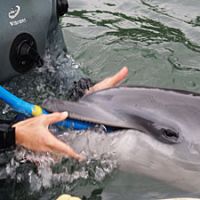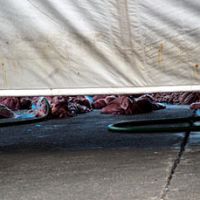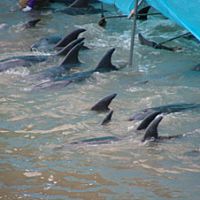Almost every day, pods of dolphins ply their way across Hatagiri Bay near the whaling town of Taiji in Wakayama Prefecture, central Japan. It's a scenic, serene area on the beautiful Kii Peninsula. But death haunts two pristine coves adjacent to Taiji's whale museum.
Every year, from September to March, thousands of dolphins are slaughtered with spears and knives during government- sanctioned oikomi (drive fisheries). In Japan as a whole, at least 400,000 dolphins have died this way over the past two decades.
But not all the captured dolphins die; some are selected as show specimens. It's all about money. Those picked as performers can fetch up to $50,000. The rest bring only $600. They end up as meat sold at local supermarkets.
Despite extremely high mercury levels repeatedly found by scientific tests in the meat of dolphins caught off Japan's coasts, however, the nation's health ministry has yet to require any warning labels on cetacean food products. Indeed, annual culling quotas of some 21,000 small cetaceans are set by the Ministry of Agriculture, Forestry and Fisheries. Taiji is one village where such culls are permitted.
Japan's drive hunts have been condemned in U.S. Senate Resolution 99, introduced in 2005, which cites their inhumaneness and the high mercury levels in dolphin meat.
Crew members on each boat were banging on long metal poles, flared at the bottom, to create a wall of sound that disoriented the dolphins' sonar. The animals clearly panicked. They were expelling water rapidly from their blowholes. Some broke away and escaped, but the others, including some calves, were trapped and hyperventilating. A few calves were unable to keep up and became separated from their mothers. They were left to die of starvation or be eaten by sharks.Last year, on Oct. 23, I left Tokyo for the "killing coves" of Taiji. The next day, Oct. 24, I witnessed my first drive fishery. It was a repulsive, barbaric event. I stood on a seawall close to the cove in Taiji into which captured dolphins are driven. Soon, I saw that out at sea a pod of dolphins was being chased. It was like a military operation. The 13 drive boats blocked every avenue of escape. The pursuit was relentless.
The doomed pod of some 25 exhausted Risso's dolphins was quickly surrounded. The drive boats herded them into the capture cove, to where I ran from my position by the seawall. I could see the animals breaking into a frenzy. These sentient mammals were looking for a way out. Smaller boats sealed off the mouth of the cove with nets. Then the drive boats left.
The atmosphere is volatile during hunts. Anyone who tries to document the drives is harassed. I, personally, was taunted, photographed and constantly followed by individuals I was told on good authority were supporting the 40- to 50-strong Isana Fishery Union in Taiji that is behind the drives. These intimidating individuals appear to operate with impunity. Even when they sometimes became unruly, the police seldom interfered. They claim to remain neutral.
The dolphin captures and killings are done in the Yoshino Kumano Kokuritsu Koen, a national park. The Ministry of the Environment manages the area. It's open to public access. Despite this, police enforce Taiji town's restrictions placed on access to the park -- selectively, it seems. l filmed many Japanese who ignored posted limits. They walked freely around recently installed security gates. Foreigners were restricted to the sidewalk, behind a rail overlooking the capture cove.
At daybreak the next morning, Oct. 25, the hoi-polloi security gang reappeared at the cove. Tension was high. Some of them held signs in English reading, "Don't Take Photos." One particularly annoying man constantly stalked me. I called him "Skyline Bob" after his aging, white Nissan Skyline. He never spoke or smiled. But he was always in my shadow.
The sound of motor boats broke the silence. It signaled the arrival of the death squad. The dolphins had only minutes to live.
Skiffs manned by fishermen armed with long knives motored into the cove. Using sweep nets, they forced the dolphins from the capture cove into the neighboring killing cove.
Some dolphins tried frantically to resist. Others that became caught in the nets were hauled into skiffs. They were taken offshore and loaded onto longboats. I could see the longboats clearly through my telephoto lens. Some crew members had long knives. Others held hoses. The men with knives made repeated stabbing motions. The dolphins' dorsal fins and tail flukes were moving wildly. The stabbing continued until the dolphins became motionless. Several of the crew hosed down blood. A man tossed entrails and blubber overboard.
All the other dolphins in the killing cove were slaughtered. Some were speared; others had their throats cut. One observer said he saw a dolphin through his camera lens that was bleeding profusely and thrashing around for many minutes.
Skiffs motoring out of the killing cove carried dead dolphins. I saw them being offloaded at the slaughterhouse in Taiji harbor. There, the corpses are kept largely hidden by big blue tarpaulins. Workers are obviously aware that photos of dead dolphins adversely affect Japan's image -- and might hit them in their pockets. The dead dolphins quickly morphed into food. Only small chunks of flesh and guts remained.
The next day, Oct. 26, about 50 bottlenose dolphins were forced into the capture cove. Drive boats had chased two separate pods for nearly six hours. One group nearly escaped. But they were no match for the tenacious hunters. The exhausted, frightened animals finally seemed to give up.
A number of calves were in those pods. The females stuck close to them and swam around them in circles trying to protect them. But, after the nets were secured across the mouth of the cove, the drive boats left.
I left the cove and headed to nearby Shingu. There, I saw fresh dolphin meat being sold in a huge supermarket. It was in 350-gram chunks. This raw, mercury-ridden meat likely came from the dolphins I had seen earlier, alive in the cove. I had come full circle in witnessing the atrocity.
Oct. 27 was a bad day. Most of the 50 captive dolphins in the cove were about to be killed in the same gut-wrenching ways in the killing cove. But it was a better day for a few.
Dolphin trainers in wetsuits soon arrived, signaling an intended live capture. A veterinarian official apparently from the Taiji Whale Museum also arrived, and appeared to be involved in selecting a few high-value "show" dolphins. Japanese trainers also participated in this. I now know that trainers often help conduct these selections in the capture cove or the killing cove. They see the slaughter. They witness the dying animals' convulsions. But when they leave, they reveal no emotion.
That morning, a half-dozen dolphins were chosen to be spared. They would most likely be trained for display. The others were moved to the killing cove and slaughtered. The lucky few were taken to holding pens in Taiji harbor. Their new homes will be in Japanese or overseas aquaria. Some would be forced to perform in spatial confinement. They would eat dead fish for life. But they'd escaped death in Taiji.
The following day I left for home. But worse was to come when I returned to Taiji on Nov. 1. Four days before, a massive capture of 150 bottlenose dolphins and 75 pilot whales had occurred. The scene at the capture cove was surreal. Blood was seeping out of the killing cove. Starving, penned-up dolphins swam listlessly in circles, calves among them. A witness to the drive said that chainsaws in the slaughterhouse had been running almost nonstop.
The magnitude of that drive, and its aftermath, resembled the "ethnic cleansing" of a species. I drove past the slaughterhouse. Piles of guts and entrails were strewn across the floor. The mess was partially hidden by a tarpaulin curtain.
The next day, I saw only a few dolphin calves languishing in the bloodied cove. This was their sixth day of survival without their mother's milk. They must have been starving. The skiffs were pulling in the nets, ignoring the calves. Some larger boats carried the final, freshly killed dolphins to the slaughterhouse.
Nov. 3 was a free pass for the dolphins. It was Culture Day in Japan (Bunka no Hi). Drive hunts were canceled.
I went to the Taiji Whale Museum to see if any calves were there. Beyond the main aquarium I spotted a small tank roped off in a restricted area. Three very young bottlenose calves were swimming in circles in the tank's filthy water. The smallest of the three lagged behind and was expelling water rapidly and very frequently from its blowhole and appeared to be struggling to stay afloat. Within a few minutes it disappeared. Ten minutes later, an angry museum official ejected me.
The tiny calf never resurfaced while I was there. I had filmed the sad event, and sent the images to two marine-mammal research scientists in the United States.
After examining the images, Diana Reiss, director of research at the Osborn Laboratories of Marine Mammal Science in New York, said by phone: "That baby's dead! . . . There's no way a (dolphin) baby could stay submerged for 10 minutes -- they usually come up two or three times a minute."
Neuroscientist Lori Marino at Atlanta's Emory University echoed Reiss's views. She said, "A dolphin baby can stay submerged no more than a minute without drowning."
Though museum officials afterward insisted the calf was safe, an informed source confirmed the death. Conditions there leave a lot to be desired. I saw two dolphins swimming erratically in the concrete show tank, and two more in an even smaller adjacent tank, while an orca (killer whale) was banging its head repeatedly against the barrier of its pen.
Most captive dolphins at the museum and in Taiji harbor were earmarked for export. A coalition headed by Ric O'Barry, a marine-mammal specialist with Earth Island Institute, said that 12 Taiji dolphins were being sent to the Dominican Republic, but the coalition was attempting to block their export.
On Nov. 4 I returned home. Each trip to Taiji was becoming harder to endure. A very well-built friend of mine named Lamar Britt accompanied me as a kind of bodyguard on my final trip to Taiji, on Nov. 20. I'd asked him along to prevent anyone blocking my efforts to film the drives.
The capture and separation of dolphin calves from their mothers is denied by the Isana Fishery Union. When three U.S. conservationists met with the fishery cooperative last November, Akira Takeuchi, head of the Isana Union, was asked if they captured mother-and-calf pairs during drive hunts.
Takeuchi denied this, telling them, "If it happens, female dolphins with nursing calves are always returned to the sea."
This contradicts what I witnessed at the museum and in the drives. Captured mothers and calves were apparently always separated -- and the mothers usually slaughtered.
Hardy Jones, executive director of the campaign group BlueVoice.org, also met with Takeuchi. Jones told me, "Taiji is an extermination camp for the dolphins . . . I can see the day when Japan will wipe out all the dolphins in its waters."
Meanwhile, back in Taiji, tension was building among the Isana group. They monitored media reports of dolphin hunts. More foreigners had come to document the drives. More of the "security" types appeared at the coves.
Prior to my trip this time, O'Barry warned me he had received death threats. "One of the fisherman told me they would kill me if they could," he said, "and he made a throat-cutting gesture with his knife." Two Japanese activists reported similar threats.
On Nov. 21, Britt and I monitored the final drive hunt of our stay from a small peninsula overlooking Hatagiri Bay. Drive boats were herding about a dozen dolphins toward the holding cove. We raced down and saw the waters churning with resisting dolphins. Boat crews kept banging on their metal poles. The animals closed ranks, spewing water. Sounds of their heavy breathing filled the air.
Within minutes, though, their fate was sealed. The pod was quickly herded into the killing cove. The doomed dolphins were an unusually large species. Some made steep dives, slapping their tail flukes violently on the water in desperation. Others leapt halfway out of the water looking for escape.
They were held in the cove for two days. Then, daybreak on Nov. 23 signaled their last hour. Britt and I waited at the cove in our rental car. The killers on the skiffs would be arriving soon.
Police suddenly pulled up in an unmarked car. They wore plain clothes, but told us politely not to trespass beyond the rail overlooking the cove. Later, another foreigner said police had told him he could enter the cove as far as the security gate. The rules were fuzzy. Paranoia pervaded the whole area.
Soon the Isana security squad showed up. The same "Skyline Bob" stalker was hot on our heels everywhere we went. Skiffs were edging the dolphins closer to the killing area. I was filming the dolphins' panic, and then I pointed my camera at our "minders." They resented being filmed. Some cursed at me.
Then all hell broke loose. A fight almost started between a foreigner and some minders. He'd tried to film the killing from the security gate. Two irate men charged him shouting "No photos! No photos!" The foreigner stood his ground. The pair finally backed off. No law bans photography in a national park.
The dolphins were killed within minutes. We saw the carcasses offloaded at the slaughterhouse. Workers were lax in hiding the bodies. A distinctive white dolphin we'd seen in the cove was among them. We saw its severed head. Its throat was cut.
Taiji's Isana Union justifies the drive fisheries as predator control. They say the dolphins deplete their fish supply. They scoff at reports that the meat is unsafe to eat.
O'Barry said, "These fishermen are poisoning their own people . . . and the Japanese government does nothing about it." He added, "This is the second Minamata" [referring to the mercury poisoning through toxic waste of thousands in Minamata, Kumumoto Prefecture, in 1956].
Photo-journalist Boyd Harnell, along with The Japan Times, won the U.S. Humane Society's "Genesis Award 2005: The Brigitte Bardot International Award," for a Nov. 30, 2005 report headlined " 'Secret' dolphin slaughter defies protests."





















With your current subscription plan you can comment on stories. However, before writing your first comment, please create a display name in the Profile section of your subscriber account page.